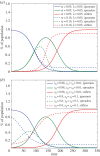A process of rumour scotching on finite populations
- PMID: 26473048
- PMCID: PMC4593682
- DOI: 10.1098/rsos.150240
A process of rumour scotching on finite populations
Abstract
Rumour spreading is a ubiquitous phenomenon in social and technological networks. Traditional models consider that the rumour is propagated by pairwise interactions between spreaders and ignorants. Only spreaders are active and may become stiflers after contacting spreaders or stiflers. Here we propose a competition-like model in which spreaders try to transmit an information, while stiflers are also active and try to scotch it. We study the influence of transmission/scotching rates and initial conditions on the qualitative behaviour of the process. An analytical treatment based on the theory of convergence of density-dependent Markov chains is developed to analyse how the final proportion of ignorants behaves asymptotically in a finite homogeneously mixing population. We perform Monte Carlo simulations in random graphs and scale-free networks and verify that the results obtained for homogeneously mixing populations can be approximated for random graphs, but are not suitable for scale-free networks. Furthermore, regarding the process on a heterogeneous mixing population, we obtain a set of differential equations that describes the time evolution of the probability that an individual is in each state. Our model can also be applied for studying systems in which informed agents try to stop the rumour propagation, or for describing related susceptible-infected-recovered systems. In addition, our results can be considered to develop optimal information dissemination strategies and approaches to control rumour propagation.
Keywords: Monte Carlo simulation; asymptotic behaviour; density-dependent Markov Chain; epidemic model; rumour process; stochastic model.
Figures












Similar articles
-
Heterogeneous update processes shape information cascades in social networks.Sci Rep. 2025 Apr 22;15(1):13999. doi: 10.1038/s41598-025-97809-3. Sci Rep. 2025. PMID: 40263500 Free PMC article.
-
A new analysis for fractional rumor spreading dynamical model in a social network with Mittag-Leffler law.Chaos. 2019 Jan;29(1):013137. doi: 10.1063/1.5080691. Chaos. 2019. PMID: 30709115
-
The rumour spectrum.PLoS One. 2018 Jan 19;13(1):e0189080. doi: 10.1371/journal.pone.0189080. eCollection 2018. PLoS One. 2018. PMID: 29351289 Free PMC article.
-
It happened to a friend of a friend: inaccurate source reporting in rumour diffusion.Evol Hum Sci. 2020 Nov 11;2:e49. doi: 10.1017/ehs.2020.53. eCollection 2020. Evol Hum Sci. 2020. PMID: 37588393 Free PMC article.
-
The silent shot: An analysis of the origin, sustenance and implications of the MMR vaccine - autism rumour in the Somali diaspora in Sweden and beyond.Glob Public Health. 2023 Jan;18(1):2257771. doi: 10.1080/17441692.2023.2257771. Epub 2023 Sep 26. Glob Public Health. 2023. PMID: 37750434
Cited by
-
Dynamic analysis and optimal control considering cross transmission and variation of information.Sci Rep. 2022 Oct 27;12(1):18104. doi: 10.1038/s41598-022-21774-4. Sci Rep. 2022. PMID: 36302934 Free PMC article.
References
-
- Castellano C, Fortunato S, Loreto V. 2009. Statistical physics of social dynamics. Rev. Mod. Phys. 81, 591–646. (doi:10.1103/RevModPhys.81.591) - DOI
-
- Lin W, Xiang L. 2014. Spatial epidemiology of networked metapopulation: an overview. Chin. Sci. Bull. 59, 3511–3522. (doi:10.1007/s11434-014-0499-8) - DOI - PMC - PubMed
-
- Agliari E, Burioni R, Cassi D, Neri FM. 2010. Word-of-mouth and dynamical inhomogeneous markets: efficiency measure and optimal sampling policies for the pre-launch stage. IMA J Manag. Math. 21, 67–83. (doi:10.1093/imaman/dpp003) - DOI
-
- Agliari E, Burioni R, Cassi D, Neri FM. 2006. Efficiency of information spreading in a population of diffusing agents. Phys. Rev. E 73, 046138 (doi:10.1103/PhysRevE.73.046138) - DOI - PubMed
-
- Keeling MJ, Eames KT. 2005. Networks and epidemic models. J. R. Soc. Interface 2, 295–307. (doi:10.1098/rsif.2005.0051) - DOI - PMC - PubMed
LinkOut - more resources
Full Text Sources
Other Literature Sources

